Another downwards day was expected to see price continue towards the target.
Summary: Price is at support, so the target may not be met. For the short term, a new high above 1,327.81 and then above the yellow best fit channel would indicate an end to the downwards swing and the start of a new upwards swing.
The target is at 1,286 if the downwards swing continues.
The mid term picture still expects that Gold is within a B wave correction which may continue for several weeks.
Only a new low below 1,236.54 would signal a strong bear market for Gold.
New updates to this analysis are in bold.
Grand SuperCycle analysis is here.
Last in-depth historic analysis with monthly and several weekly charts is here, video is here.
There are multiple wave counts at this time at the weekly and monthly chart levels. In order to make this analysis manageable and accessible only two will be published on a daily basis, one bullish and one bearish. This does not mean the other possibilities may not be correct, only that publication of them all each day is too much to digest. At this stage, they do not diverge from the two possibilities below.
BULLISH ELLIOTT WAVE COUNT
FIRST WEEKLY CHART
Cycle wave b may be a single zigzag. Zigzags subdivide 5-3-5. Primary wave C must subdivide as a five wave structure and may be either an impulse or an ending diagonal. Overlapping at this stage indicates an ending diagonal.
Within an ending diagonal, all sub-waves must subdivide as zigzags. Intermediate wave (4) must overlap into intermediate wave (1) price territory. This diagonal is expanding: intermediate wave (3) is longer than intermediate wave (1) and intermediate wave (4) is longer than intermediate wave (2). Intermediate wave (5) must be longer than intermediate wave (3), so it must end above 1,398.41 where it would reach equality in length with intermediate wave (3).
Within the final zigzag of intermediate wave (5), minor wave B may not move beyond the start of minor wave A below 1,236.54.
Within intermediate wave (1), the correction labelled minor wave B was over within one week. Within intermediate wave (2), the correction labelled minor wave B was too quick to be seen on the weekly chart. Within intermediate wave (3), the correction labelled minor wave B was over in 12 weeks, one short of a Fibonacci 13. Within intermediate wave (4), the correction labelled minor wave B was over in a Fibonacci 8 weeks. As each actionary wave is extending in time as well as price, the correction of minor wave B within intermediate wave (5) may be longer than that within intermediate wave (3). At this early stage, a Fibonacci 13 or possibly even 21 weeks may be expected. This expectation is a rough guideline; flexibility is essential when B waves unfold.
This first weekly chart sees the upwards wave labelled primary wave A as a five wave structure. It must be acknowledged that this upwards wave looks better as a three than it does as a five. The fifth weekly chart below will consider the possibility that it was a three.
FIRST DAILY CHART
Within the ending diagonal, intermediate wave (5) must sub-divide as a zigzag.
Minor wave B may be a reasonably time consuming consolidation or a quicker sharper pullback within the upwards trend, and it may end about either of the 0.382 or 0.618 Fibonacci ratios (neither may be favoured).
There are more than 23 possible structures that minor wave B may take, and it is impossible until close to or at the end to have confidence which structure has unfolded. When B waves unfold, it is essential that analysis is flexible. B waves are analogous to either range bound consolidations or sharp corrections. As minor wave B unfolds, the labelling on the hourly chart for its sub-waves will change and alternates will be required from time to time.
The yellow arrow again outlines the possible pathway for a flat or combination. These corrections are analogous to sideways range bound consolidations. Within both a flat and consolidation, minute wave b or x may make a new high above the start of minute wave a or w at 1,365.68.
Minor wave B may still be a triangle or zigzag. All possibilities must still be considered.
Minor wave B may not move beyond the start of minor wave A below 1,236.54.
HOURLY CHART
Today’s classic technical analysis favours this first hourly chart.
A zigzag downwards may be complete, which may be minute wave a. Within the zigzag, there is an excellent Fibonacci ratio between minuette waves (a) and (c).
If minute wave a has subdivided as a zigzag, then minor wave B may be any one of either a flat, triangle, combination or double zigzag.
Within flats and combinations, minute wave b or x may be very deep. Within a flat correction, minute wave b must retrace a minimum 0.9 length of minute wave a.
Within a triangle, there is no minimum requirement for minute wave b, but it does need to subdivide as a three wave structure.
All of a flat, combination or triangle would see price continue to find support here about 1,310 to 1,305, at least for the short to mid term.
Within a double zigzag, minute wave x should be relatively brief and shallow. (Note: A double zigzag would not follow the pathway of the yellow arrow here.)
Within all the possible corrective structures that may continue for minor wave B, the next upwards wave for minute wave b or x should exhibit internal weakness. B waves often have light volume and at their extremes exhibit divergence between price and indicators.
ALTERNATE HOURLY CHART
An impulse downwards may be continuing. This may be minute wave a within a zigzag for minute wave b.
The middle of the impulse may have passed. If this is correct, then subminuette wave iv may now not move into subminuette wave i price territory above 1,327.81.
When minute wave a completes, then minute wave b should unfold. Minute wave b may be a quick sharp bounce, or it may be a very complicated time consuming sideways movement. It may not move beyond the start of minute wave a.
The final target for minor wave B for this wave count would now most likely be the 0.618 Fibonacci ratio of minor wave A at 1,286.
SECOND ALTERNATE HOURLY CHART
If a zigzag downwards is complete, then the possibility that minor wave B may be over in its entirety must be considered.
If price makes a new high above 1,327.81 and breaks above the yellow channel, then both the first hourly chart and this second alternate hourly chart will be valid.
If upwards movement shows strength, then this wave count may be favoured.
BEARISH ELLIOTT WAVE COUNT
FIFTH WEEKLY CHART
There were five weekly charts published in the last historic analysis. This fifth weekly chart is the most immediately bearish wave count, so this is published as a bearish possibility.
This fifth weekly chart sees cycle wave b as a flat correction, and within it intermediate wave (B) may be a complete triple zigzag. This would indicate a regular flat as intermediate wave (B) is less than 1.05 the length of intermediate wave (A).
If cycle wave b is a flat correction, then within it primary wave B must retrace a minimum 0.9 length of primary wave A at 1,079.13 or below. The most common length of B waves within flats is from 1 to 1.38 times the length of the A wave. The target calculated would see primary wave B end within this range.
I have only seen two triple zigzags before during my 10 years of daily Elliott wave analysis. If this wave count turns out to be correct, this would be the third. The rarity of this structure is identified on the chart.
TECHNICAL ANALYSIS
WEEKLY CHART
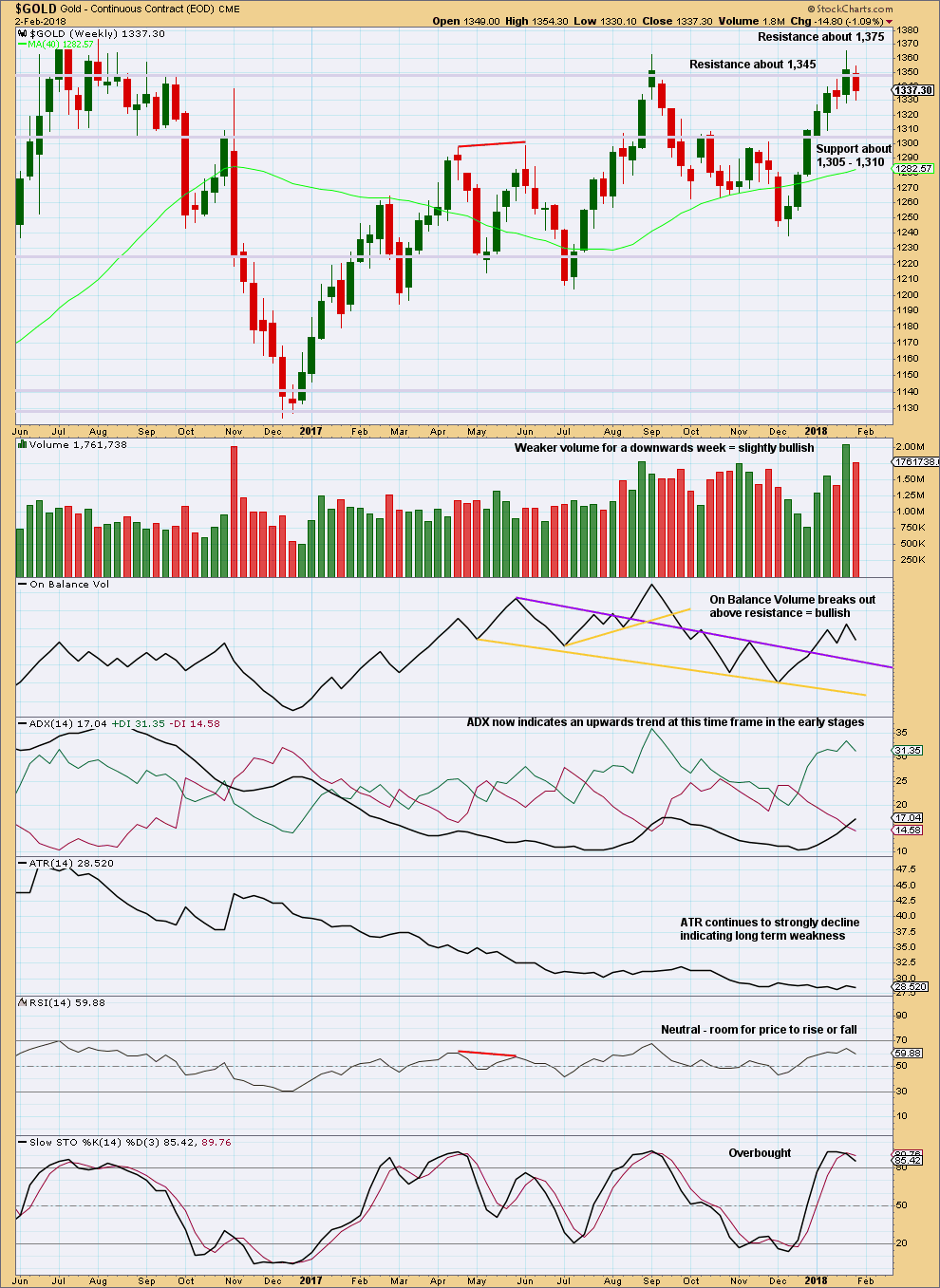
Click chart to enlarge. Chart courtesy of StockCharts.com.
Again, price could not remain above resistance at 1,345 and has closed back below this point. Price remains range bound at this time frame with resistance about 1,378 and support about 1,225. During this consolidation, it is now an upwards week that has strongest volume suggesting an upwards breakout may be more likely than downwards.
Last week’s upwards movement had strong support from volume. This week’s downwards movement does not. The short term volume profile remains bullish.
However, with price at resistance and Stochastics overbought, it would be reasonable to expect an end to the upwards swing here and a downwards swing to support.
DAILY CHART
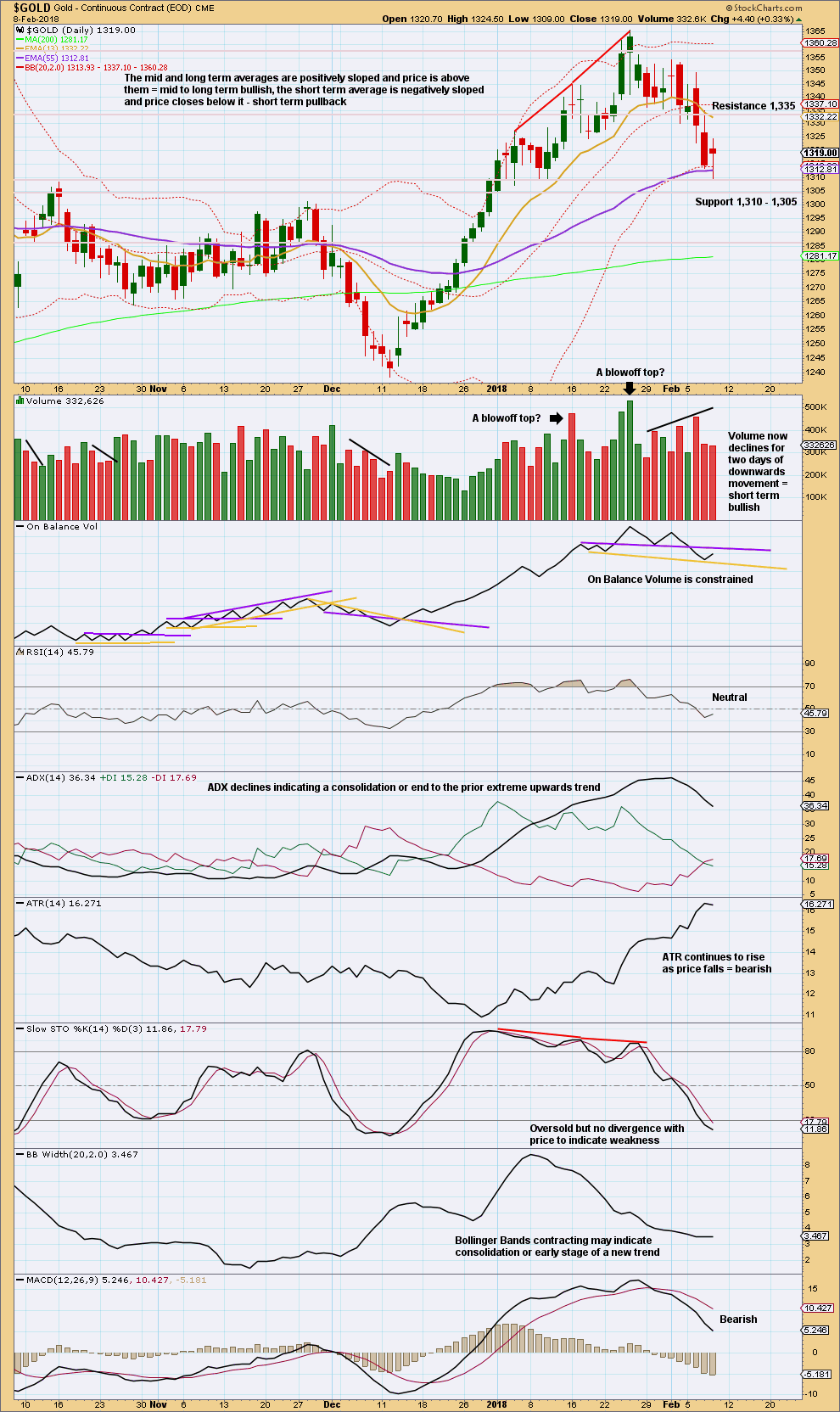
Click chart to enlarge. Chart courtesy of StockCharts.com.
The long lower wick and weak volume today suggest some upwards movement tomorrow to bounce here off support. Support about 1,310 to 1,305 is strong.
With price at support now and Stochastics oversold, it looks reasonable to now expect an end to this downwards swing here or very soon and the start of a new upward swing.
GDX DAILY CHART
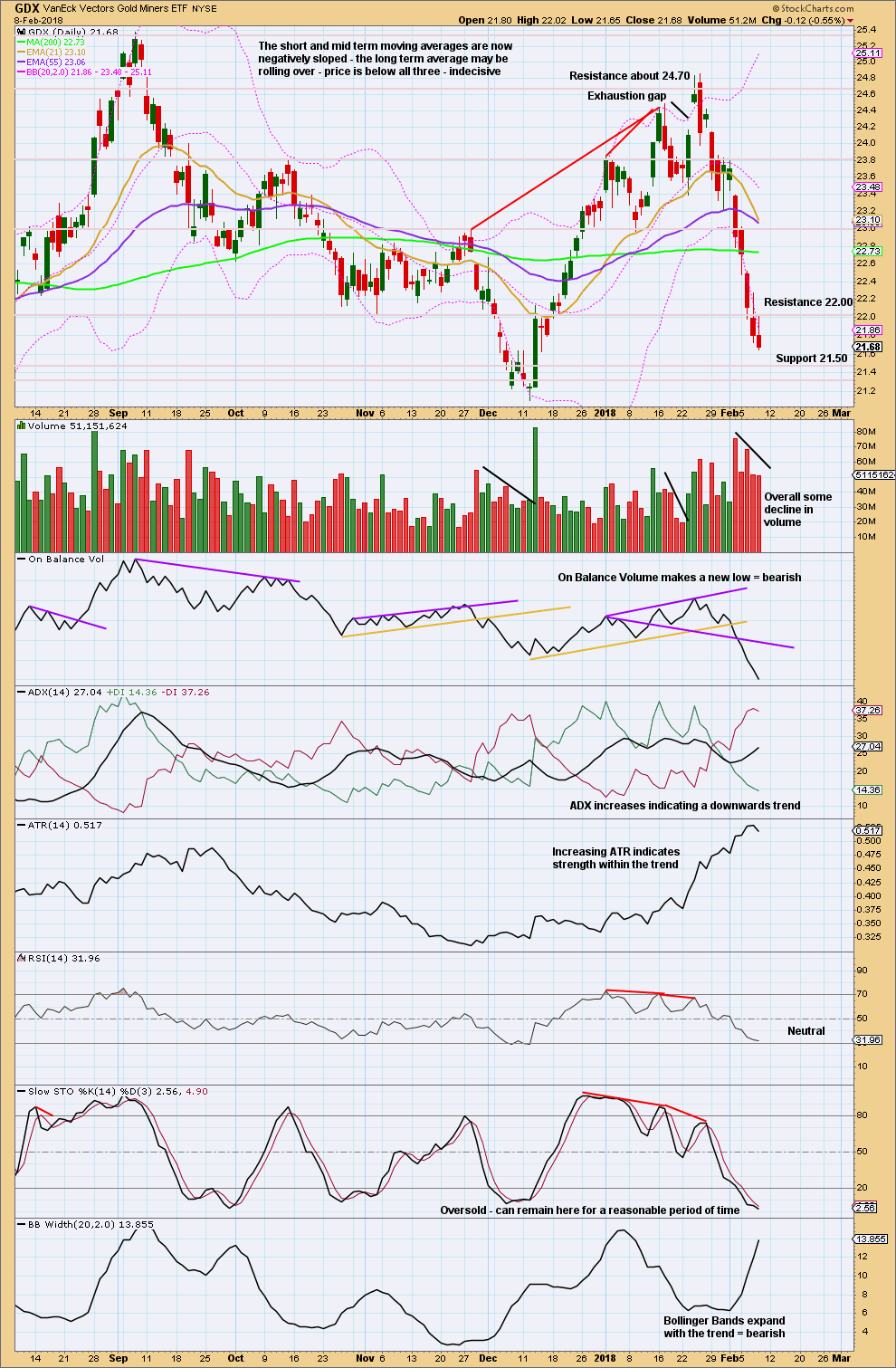
Click chart to enlarge. Chart courtesy of StockCharts.com.
GDX looks more immediately bearish than Gold today. The long upper wicks on the last two daily candlesticks are bearish. On Balance Volume is very bearish. RSI indicates there is further room for price to fall.
Published @ 07:00 p.m. EST.

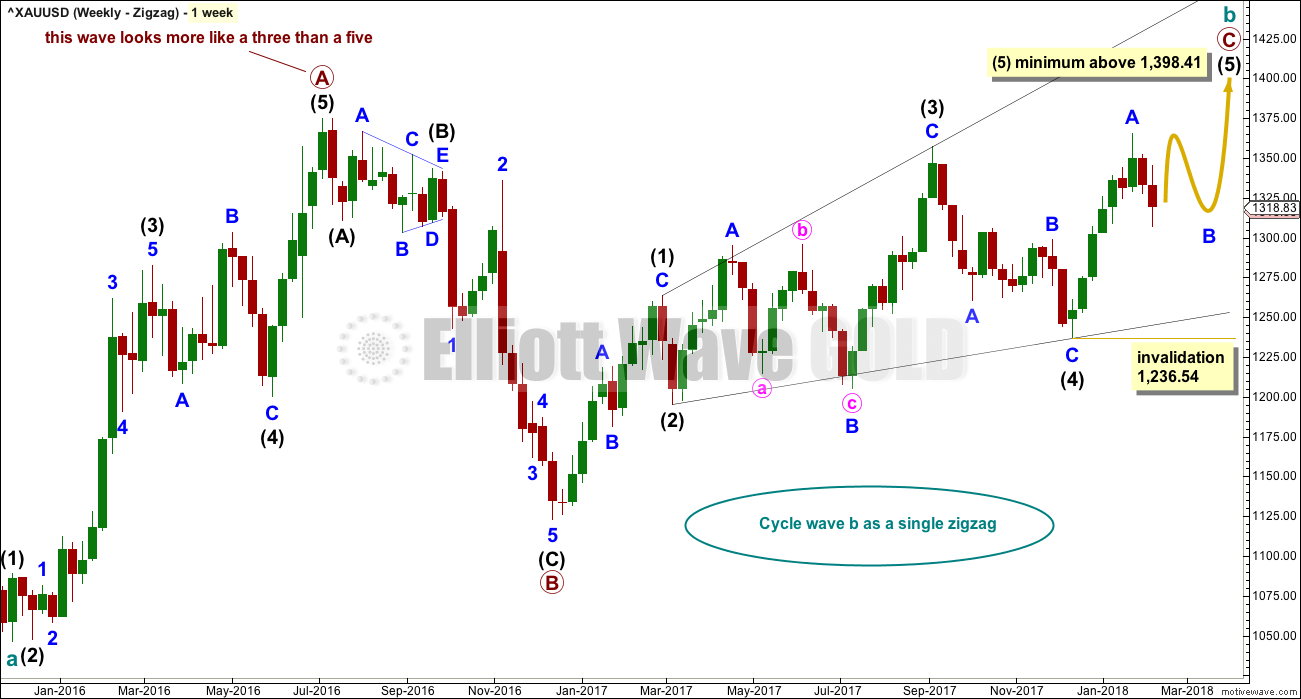
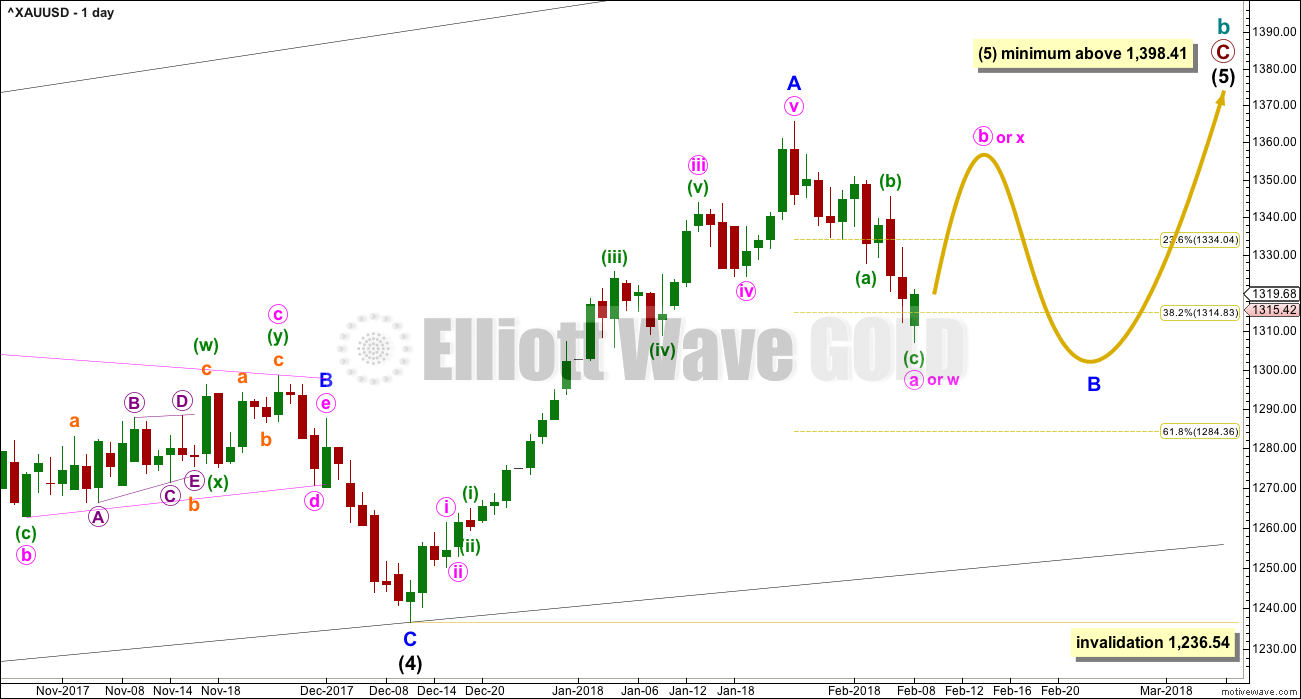
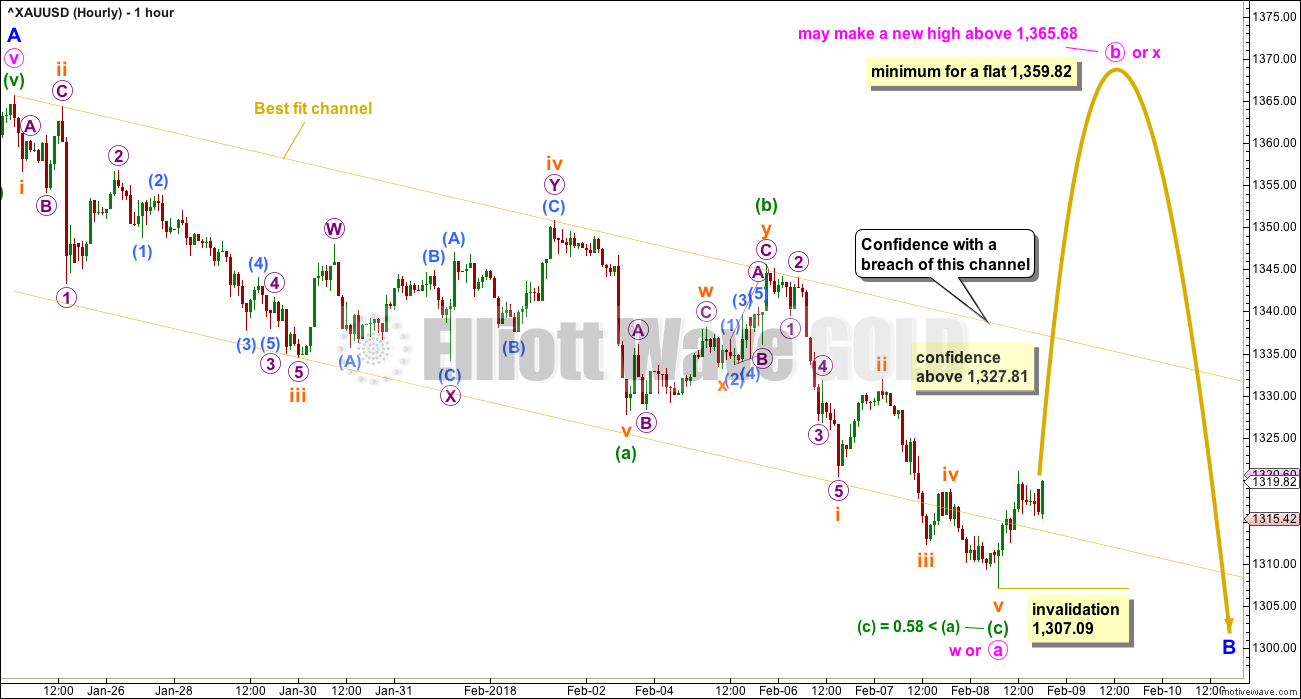
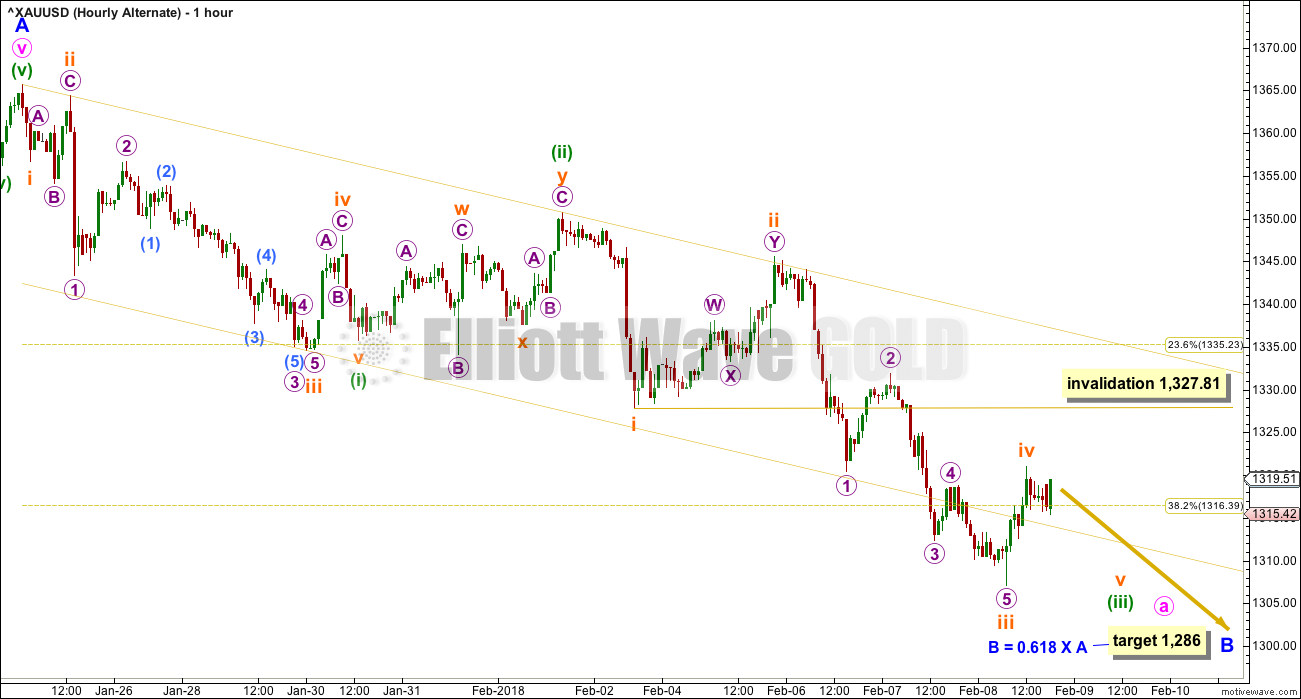
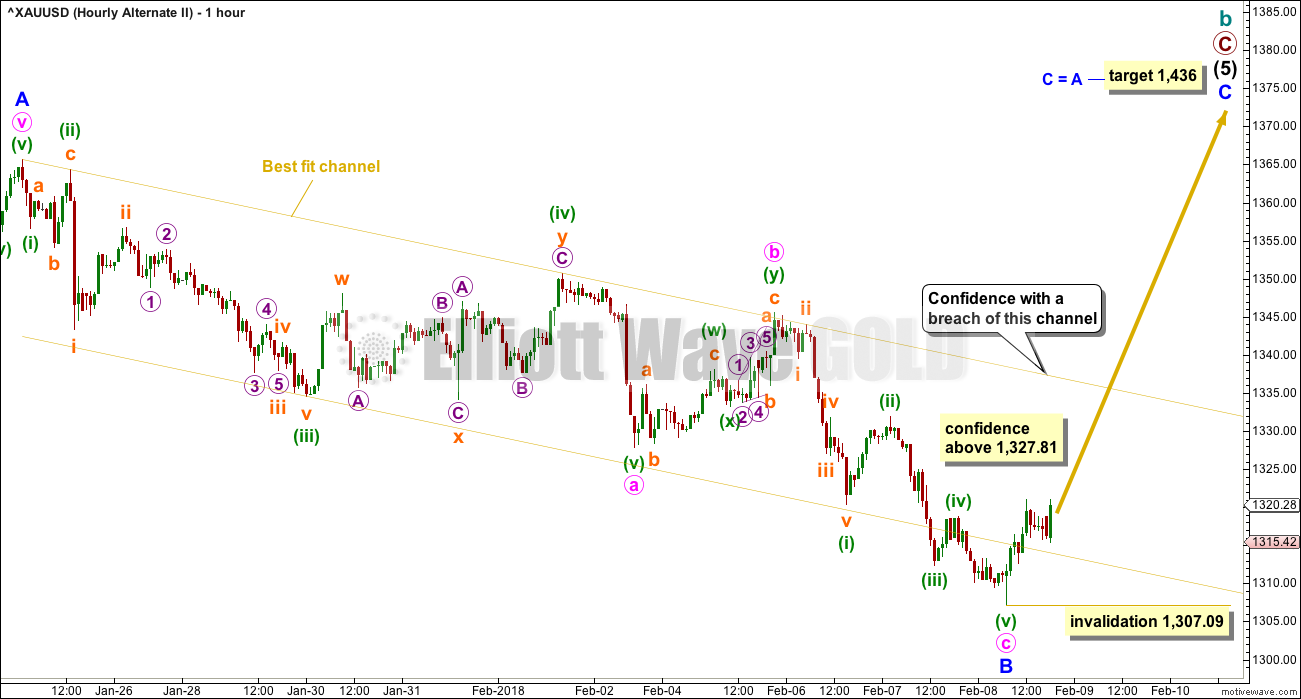
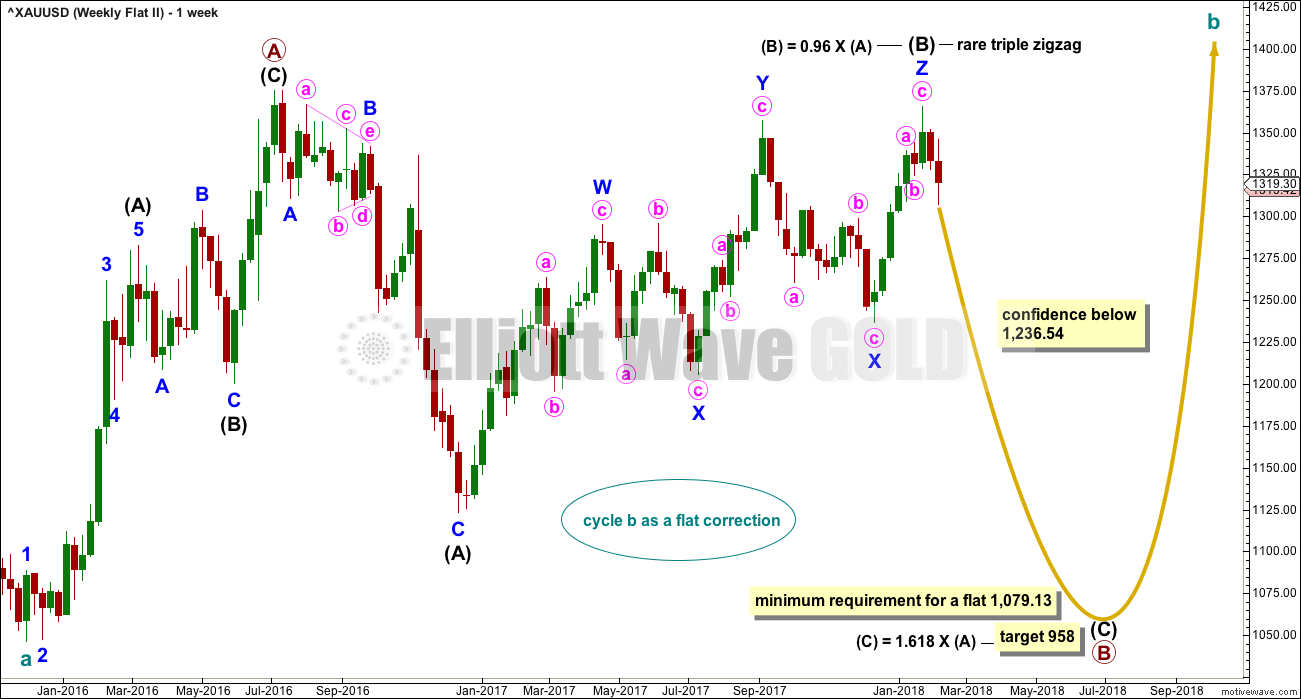
updated main hourly chart:
no change to the analysis with this small range inside day so far
this sideways movement is particularly difficult to figure out though, I need some time on the 5 minute chart.
if this is the start of a B wave upwards, then that makes sense.
Lara: “Today’s classic technical analysis favours this first hourly chart.”
Yes indeed. Plus candlestik chart pattern is bullish on hourly chart. Two long green candles surrounds many small body red candles.
Thanks Lara.
You’re welcome.
I’ve learned over the years to pay attention to the candlestick wicks. Long wicks are very often (not always) an indication of a price turn.
That’s not saying anything about how far the next move may go, only a turn at the point of long wicks.